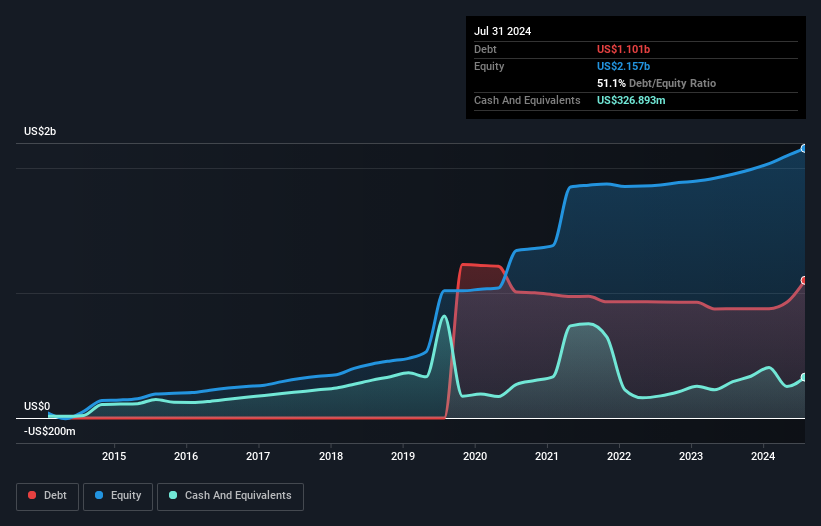We Think HealthEquity (NASDAQ:HQY) Can Stay On Top Of Its Debt
HealthEquity Inc HQY | 96.81 | +0.90% |
Warren Buffett famously said, 'Volatility is far from synonymous with risk.' So it seems the smart money knows that debt - which is usually involved in bankruptcies - is a very important factor, when you assess how risky a company is. Importantly, HealthEquity, Inc. (NASDAQ:HQY) does carry debt. But the more important question is: how much risk is that debt creating?
When Is Debt Dangerous?
Debt is a tool to help businesses grow, but if a business is incapable of paying off its lenders, then it exists at their mercy. Ultimately, if the company can't fulfill its legal obligations to repay debt, shareholders could walk away with nothing. However, a more usual (but still expensive) situation is where a company must dilute shareholders at a cheap share price simply to get debt under control. Having said that, the most common situation is where a company manages its debt reasonably well - and to its own advantage. The first step when considering a company's debt levels is to consider its cash and debt together.
How Much Debt Does HealthEquity Carry?
The image below, which you can click on for greater detail, shows that at July 2024 HealthEquity had debt of US$1.10b, up from US$873.6m in one year. However, it also had US$326.9m in cash, and so its net debt is US$774.5m.

How Strong Is HealthEquity's Balance Sheet?
According to the last reported balance sheet, HealthEquity had liabilities of US$120.9m due within 12 months, and liabilities of US$1.24b due beyond 12 months. On the other hand, it had cash of US$326.9m and US$108.5m worth of receivables due within a year. So its liabilities outweigh the sum of its cash and (near-term) receivables by US$922.1m.
Of course, HealthEquity has a market capitalization of US$7.61b, so these liabilities are probably manageable. However, we do think it is worth keeping an eye on its balance sheet strength, as it may change over time.
We measure a company's debt load relative to its earnings power by looking at its net debt divided by its earnings before interest, tax, depreciation, and amortization (EBITDA) and by calculating how easily its earnings before interest and tax (EBIT) cover its interest expense (interest cover). The advantage of this approach is that we take into account both the absolute quantum of debt (with net debt to EBITDA) and the actual interest expenses associated with that debt (with its interest cover ratio).
HealthEquity has net debt worth 2.3 times EBITDA, which isn't too much, but its interest cover looks a bit on the low side, with EBIT at only 4.6 times the interest expense. While that doesn't worry us too much, it does suggest the interest payments are somewhat of a burden. Pleasingly, HealthEquity is growing its EBIT faster than former Australian PM Bob Hawke downs a yard glass, boasting a 114% gain in the last twelve months. There's no doubt that we learn most about debt from the balance sheet. But it is future earnings, more than anything, that will determine HealthEquity's ability to maintain a healthy balance sheet going forward.
Finally, while the tax-man may adore accounting profits, lenders only accept cold hard cash. So it's worth checking how much of that EBIT is backed by free cash flow. During the last three years, HealthEquity burned a lot of cash. While that may be a result of expenditure for growth, it does make the debt far more risky.
Our View
HealthEquity's conversion of EBIT to free cash flow was a real negative on this analysis, although the other factors we considered were considerably better. In particular, we are dazzled with its EBIT growth rate. We would also note that Healthcare industry companies like HealthEquity commonly do use debt without problems. Considering this range of data points, we think HealthEquity is in a good position to manage its debt levels. Having said that, the load is sufficiently heavy that we would recommend any shareholders keep a close eye on it. The balance sheet is clearly the area to focus on when you are analysing debt. But ultimately, every company can contain risks that exist outside of the balance sheet. To that end, you should be aware of the 1 warning sign we've spotted with HealthEquity .
At the end of the day, it's often better to focus on companies that are free from net debt. You can access our special list of such companies (all with a track record of profit growth). It's free.
This article by Simply Wall St is general in nature. We provide commentary based on historical data and analyst forecasts only using an unbiased methodology and our articles are not intended to be financial advice. It does not constitute a recommendation to buy or sell any stock, and does not take account of your objectives, or your financial situation. We aim to bring you long-term focused analysis driven by fundamental data. Note that our analysis may not factor in the latest price-sensitive company announcements or qualitative material. Simply Wall St has no position in any stocks mentioned.




